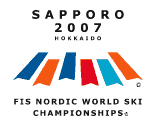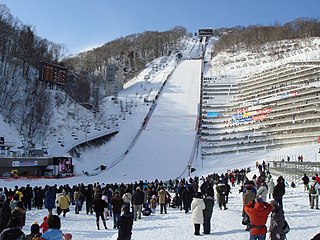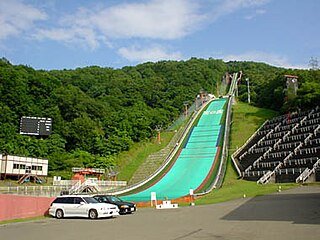For the 1972 Winter Olympics in Sapporo, Japan, a total of twelve sports venues were used. A thirteenth venue which was a reserved luge course was constructed, but never used in actual competition. Construction on all of the venues used took place between 1968 and early 1971 in time for the test events. The Tsuskisamu Indoor Skating Rink was not completed until late 1971 or early 1972 because the number of teams scheduled to compete at the 1972 Games was not known. At the actual luge venue used, a malfunctioning starting gate during the first run led to the results being cancelled and rerun being ordered. The results of this event led to the only tie in Olympic luge history. The ski jumps at Miyanomori and Okurayama served as host venues for the FIS Nordic World Ski Championships thirty-five years later.
| Venue | Sports | Capacity | Ref. |
|---|---|---|---|
| Makomanai Biathlon site | Biathlon | Not listed. | [1] |
| Makomanai Cross-country site | Cross-country skiing, Nordic combined (cross-country skiing) | Not listed. | [1] |
| Makomanai Ice Arena | Figure skating, Ice hockey, Closing ceremonies | 11,500 | [2] |
| Makomanai Speed Skating Rink | Opening ceremonies, Speed skating | 30,000 | [3] |
| Mikaho Indoor Skating Rink | Figure skating | 12,000 | [4] |
| Tsukisamu Indoor Skating Rink | Ice hockey | 6,000 | [5] |
A reserve luge course was constructed 9 km (5.6 mi) south of Sapporo's Olympic village at the Fujino ski area, but was never used. Constructed between June 1968 and November 1971, the track cost ¥106 million to build. It was 1,000 m (3,300 ft) long for men's singles and 924.55 m (3,033.3 ft) long for women's singles and men's doubles, had 14 turns for all three luge disciplines, and had a 10% average gradient for the track. No turn names were given. [6]
| Venue | Sports | Capacity | Ref. |
|---|---|---|---|
| Miyanomori Jumping Hill | Nordic combined (ski jumping), Ski jumping (normal hill) | Not listed. | [7] |
| Mount Eniwa Downhill Course | Alpine skiing (downhill) | Not listed. | [8] |
| Mt. Teine Alpine Skiing courses | Alpine skiing (slalom, giant slalom) | Not listed. | [9] |
| Mt. Teine Bobsleigh Course | Bobsleigh | Not listed. | [9] |
| Mt. Teine Luge Course | Luge | Not listed. | [9] |
| Okurayama Jumping Hill | Ski jumping (large hill) | 50,000 | [10] |
At the 1936 Winter Olympics in Garmisch-Partenkirchen, Germany, the International Olympic Committee (IOC), the decision to award the 1940 Winter Olympics was suspended. This was because of an issue with amateurism between the IOC and the International Ski Federation. Three years earlier, at an IOC meeting in Oslo, Japan had expressed an interest in hosting the Winter Olympics, with Sapporo and Nikkō as possible locations, though four other sites were also considered. Because Tokyo had been awarded host of the 1940 Summer Olympics, the IOC awarded Japan the 1940 Winter Games. This was confirmed by the IOC at the 1937 meeting in Cairo on the condition that the 1940 Games would be given to Norway if Japan could not organize the preparations by the fall of 1938. One of the venues of the 1940 Winter Games that would be included in the 1972 Winter Olympics was the Mount Okura ski jump. [11] In July 1937, Japan's second invasion of China began, and despite being awarded the 1940 Winter Olympics, Sapporo was forced to withdraw from hosting the 1940 Winter Olympics as was Tokyo with the 1940 Summer Olympics. [12]
Okurayama was constructed using private funds in 1931. [13]
At the 1959 IOC Meeting in Munich, Tokyo was selected to host the 1964 Summer Olympics. [12] This inspired Sapporo to try to host the 1968 Winter Olympics. [12] Sapporo submitted its bid in 1963 to the IOC. [12] On 29 January 1964 at the IOC Meeting in Innsbruck, Sapporo finished a distant fourth to winner Grenoble for the 1968 Winter Games. [14] Following observations of the 1964 Summer Games in Tokyo, an aggressive public relations campaign began with Sapporo and the IOC to bring the 1972 Winter Games to Sapporo. [15] This campaign proved fruitful when Sapporo was awarded the 1972 Winter Games at the April 1966 IOC meeting in Rome. [15]
Venue construction began in 1968 and all but the Tsukisamu Indoor rink was completed in time for the test events at Sapporo in February 1971. Tsukisamu was not completed until late 1971 or early 1972 due to not knowing how many teams would compete at the 1972 Olympic ice hockey tournament. [16]
During the men's 5000 m speed skating event, Ard Schenk of the Netherlands won the event despite a snowstorm. [17] It was the first of Schenk's three gold medals at the games. [17]
The only noted venue issue was at the Mt. Teine Luge Course was in the men's doubles event when a malfunctioning starting gate cancelled the results of the first run. [18] Italy, whose doubles team of Paul Hildgartner and Walter Plaikner won the first run, protested to event officials the results should stand since all contestants had suffered equally, but to no avail. [18] After the protest was denied, a rerun was ordered. [18] Hildgartner and Plaikner won the first run of the rerunned event while the East German team of Horst Hörnlein and Reinhard Bredow had the fastest second run. [19] The combined times were equal for the only time in Winter Olympic luge history. [19] The International Luge Federation consulted with IOC President Avery Brundage on this matter, and gold medals were awarded to both teams as a result. [18] By the time of the 1976 Winter Olympics, artificial track luge would be timed in thousandths of a second (0.001) rather than hundredths of a second (0.01) in an effort to avoid ties. [20] That would prove effective until the FIL European Luge Championships 2008 at Cesana, when another tie occurred. [21] This tie was again in the men's doubles event and it again involved Italy and Germany (East and West Germany reunified in 1990) only this time it was for a bronze medal rather than gold. [21]
The biathlon and cross-country skiing venues at Makomanai were temporary venues and torn down after the Olympics. [1] The bobsleigh and luge tracks were used for recreational purposes, but no other competitions after the Olympics were held there. [22] When Nagano was awarded the 1998 Winter Olympics in June 1991, the tracks were dismantled. [22]
Okurayama and Miyanomori would serve as the ski jumping venues for the ski jumping and the ski jumping portion of the Nordic combined events when Sapporo hosted the FIS Nordic World Ski Championships in 2007. [23] [24] [25] [26] It has been on the Ski Jumping World Cup circuit on an almost annual basis since 1980. [27]
Mount Teine remains a popular alpine skiing site that has been in use since the 1972 Games. [28]
The 1972 Winter Olympics, officially the XI Olympic Winter Games and commonly known as Sapporo 1972, were a winter multi-sport event held from February 3 to 13, 1972, in Sapporo, Hokkaido Prefecture, Japan. It was the first Winter Olympic Games to take place outside Europe and North America.
Ski jumping at the 1972 Winter Olympics consisted of two events held from 6 to 11 February 1972, with the large hill event taking place at Okurayama Ski Jump Stadium, and the normal hill event at Miyanomori Ski Jump Stadium.

The FIS Nordic World Ski Championships 2007 took place 22 February – 4 March 2007 in Sapporo, Japan. It was the second time this city has hosted these championships, having previously done so in the 1972 Winter Olympics. Sapporo was selected as venue by vote at the 43rd FIS World Congress in Portorož, Slovenia, on 6 June 2002. It also marked the third time the championships were hosted outside Europe in a year that did not coincide with the Winter Olympics; it was the first championship held in Asia. The ski jumping team normal hill event was not held, as it had been in 2005.

Sapporo is a city in Japan. It is the largest city north of Tokyo and the largest city in Hokkaido, the northernmost main island of the country. It ranks as the fifth most populous city in Japan. It is the capital city of Hokkaido Prefecture and Ishikari Subprefecture. Sapporo lies in the southwest of Hokkaido, within the alluvial fan of the Toyohira River, which is a tributary stream of the Ishikari. It is considered the cultural, economic, and political center of Hokkaido.

Chūō-ku is one of the ten wards in Sapporo, Hokkaido, Japan. Chūō-ku means "central ward" in Japanese. City administration and entertainment facilities are centred in this ward.
The Nordic combined at the FIS Nordic World Ski Championships 2007 took place at the FIS Nordic World Ski Championships 2007 in Sapporo, Japan on February 23, February 25, and March 3, 2007.
The ski jumping at the FIS Nordic World Ski Championships 2007 was part of the FIS Nordic World Ski Championships 2007 that took place in Sapporo, Japan, on February 24, February 25, and March 3, 2007.

The Ōkurayama Ski Jump Stadium, also known as the Ōkurayama-Schanze is a ski jumping venue located in the Miyanomori area in Chūō-ku, Sapporo, Hokkaidō, Japan. Owned mostly by Sapporo City, the ski jump is on the eastern slope of the Mt. Okura. The stadium has hosted a number of winter sports events including 1972 Winter Olympics and FIS Nordic World Ski Championships 2007. The area of stadium consists of the Winter Sports Museum, the Ōkurayama Crystal House, and the Mt. Okura Observation Platform, as well as the ski jump.
For the 1924 Winter Olympics in Chamonix, France, a total of three sports venues were used. The main stadium was used for all but two sports and part of a third. It was the first ski jump used for the Winter Olympics. A bobsleigh track was prepared for use.
For the 1964 Winter Olympics in Innsbruck, Austria, a total of eight sports venues were used. Luge made its debut at these games, but were marred by the death of a British slider two weeks prior to the Games. A second ski jumping event debuted and the best two out of three jumps were used in both events for the only time in the history of the Winter Olympics. All eight venues would be used again when the Winter Games returned to Innsbruck twelve years later though the venues would undergo renovations in time for the 1976 Games.

For the 1976 Winter Olympics in Innsbruck, Austria, a total of eight sports venues were used. The games were originally awarded to Denver, Colorado in the United States in 1970, but they withdrew in the wake of Colorado residents voting against it for environmental and cost reasons in November 1972. This led to the International Olympic Committee opening up the bids for the games again, eventually awarding them to Innsbruck in February 1973. The Austrian city, having hosted the Winter Olympics in 1964, was in the process of having the venues used for those Games before Denver's with clear cutting of the alpine skiing venues, lessening of the amount of cross-country skiing routes, upgrading the ski jumps, adding lighting in the indoor sports arena to accommodate color television, and the construction of a combination bobsleigh and luge track. After the 1976 Games, the venues have remained in use, hosting events in Nordic skiing and the sliding sports. They hosted some of the events for the Winter Universiade in 2005 and seven of the eight venues served as host for the first Winter Youth Olympic Games in 2012.

For the 1980 Winter Olympics in Lake Placid, New York, United States, a total of seven sports venues were used. All five of the venues used for the 1932 Winter Olympics were also used at the 1980 Winter Games with adjustments. These adjustments included electronic scoreboards, increased refrigeration, and the addition of a separate luge track. This was the last Winter Olympics where there were separate bobsleigh and luge tracks. The closest finish in Olympic history in cross-country skiing led skiing officials to time future events in hundredths of a second rather than tenths of a second. This would also apply to biathlon events. Eric Heiden won five gold medals at the speed skating oval while the "Miracle on Ice" took place between Americans and Soviets at the Olympic Center. In the late 1990s, the luge track was demolished and a new combination track was constructed in time for the only Winter Goodwill Games held. The sliding venue was named to the American National Register of Historical Places in February 2010.
For the 1984 Winter Olympics in Sarajevo, Yugoslavia, a total of nine sports venues were used. The idea for the Games came around from a 1968 Organisation for Economic Co-operation and Development study on promoting winter tourism in Yugoslavia. After Sarajevo was awarded the 1984 Games in 1978, venue construction and renovation took place between 1979 and 1983. Weather postponed the men's downhill alpine skiing event three times before it was finally run. The men's cross-country skiing 30 km event was run during a blizzard. After the games, all but one of the venues were damaged during the Bosnian War and the siege of Sarajevo. After the war, Zetra Ice Hall was rebuilt and is in use as of 2010.

For the 1988 Winter Olympics in Calgary, Alberta, Canada, a total of nine sports venues were used. Calgary tried twice to host the Winter Olympics in the 1960s without success before finally winning the 1988 Winter Games in 1981. Stampede Corral was built in 1950 while McMahon Stadium was built in 1960. When the National Hockey League (NHL) Flames franchise was relocated from Atlanta, Georgia in the United States during the summer of 1980, a new arena was needed. The Saddledome construction was underway in late 1981 when Calgary was awarded the 1988 Games. Completed in 1983, the Olympic Saddledome has played host to the Flames ever since, including three Stanley Cup Finals and the NHL All-Star Game in 1985. An innovation for the games was the first indoor long-track speed skating venue which has served as a model for future Olympics. The bobsleigh and luge track was the first combination track in North America and was noted for the Jamaican bobsleigh team crash during the four-man event. Both the Oval and the bobsleigh/luge track continue to host the World Championships in their respective sports since the 1988 Winter Olympics.

For the 1998 Winter Olympics in Nagano, Japan, a total of fifteen sports venues were used. Nagano had attempted twice to host the Winter Olympics, losing out to Sapporo, host of the 1972 Winter Olympics. The third time, in 1991, Nagano edged out Salt Lake City to host the 1998 Games. The biathlon venue was adjusted in accordance with the Washington Convention over endangered species. The biggest venue controversy was at Happo'one resort on the length of the men's downhill and the battle that ensued to the point where skiing officials threatened to pull the event entirely before a compromise was reached three months before the Olympics. M-Wave has hosted three World Speed Skating Championships since the Olympics, while the Spiral has hosted a couple of world championships in bobsleigh, luge and skeleton.

For the 2006 Winter Olympics in Turin, Italy, a total of fifteen sports venues were used. Venue construction ran from 2002 to 2005. Cesana Pariol had to have turns 17 and 18 modified following the Luge World Cup in January 2005, but they were not cleared out until October 2005. Winds postponed the Nordic combined team event for a day. Many of the venues served as host for the Winter Universidade the following year.

Sapporo Teine (サッポロテイネ) is a recreational center in Teine-ku, Sapporo, Hokkaido, Japan. It comprises many facilities, such as the ski resort, the Teineyama Ropeway, and the Sapporo Teine Golf Club fields.

The Miyanomori Ski Jump Stadium, also known as the Miyanomori-Schanze is a ski jumping venue located in the Miyanomori area in Chūō-ku, Sapporo, Hokkaidō, Japan. The stadium has hosted a number of winter sports events including 1972 Winter Olympics and FIS Nordic World Ski Championships 2007.
The Doubles luge competition at the 1972 Winter Olympics in Sapporo was held on 10 February, at Sapporo Teine. A malfunctioning starting gate cancelled the results of the first run. Italy, whose doubles team of Paul Hildgartner and Walter Plaikner won the first run, protested to event officials the results should stand since all contestants had suffered equally, but to no avail. After the protest was denied, a rerun was ordered.